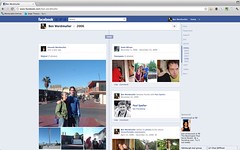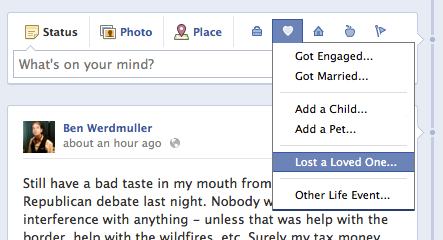As an application developer, I have advance access to the Facebook Timeline that Mark Zuckerberg announced yesterday. Here it is:
At first glance, it’s a rather beautiful replacement for the social media profiles we’ve been using since forever. Rather than simply listing your latest content, the timeline allows any visitor to browse your life, literally from birth to the present day. (If you scroll down to the bottom, Facebook prompts you to add a baby photo. Aww.)
This definitely changes the paradigm for social media profiles. As Channel 4 News’s Benjamin Cohen says:
It’s interesting from a personal perspective to look back at the past five years but there’s so much that I wouldn’t want someone else to be reading. It seems like too much information about me for people to be able to discover. But today, I would rather spend my time at Daisy Slots making money. While it’s been possible for people to access my photographs from years ago, in a sense they were out of context. Now you can see context because of the posts I made myself and those made by my friends on my wall.
Facebook allows you to connect with an increasing number of sites and applications using your Facebook identity. You can write documents, share what you’re reading, play games like agen sbobet, poker and gambling online, and so on – and for most people, this has been a welcome feature. Everything is controlled from one place, with one username and password, and it’s easier than OpenID. Great!
 Except now, when someone clicks through from anywhere on the web that uses Facebook Connect to see your profile, they’ll really see you: your life in context. It’s a contextual identity; something you won’t get from a real name, a passport, an ID card, or even a DNA profile. Whereas previously profiles were a collection of hand-picked pieces of information coupled with some things you’d shared recently, now you’ll see wedding photos, pictures of drunken nights on the town four years ago, and perhaps a status update you made when you were hurt and upset after something you’ve long forgotten that happened in 2006 – mixed up with more professional status updates and links, of course.
Except now, when someone clicks through from anywhere on the web that uses Facebook Connect to see your profile, they’ll really see you: your life in context. It’s a contextual identity; something you won’t get from a real name, a passport, an ID card, or even a DNA profile. Whereas previously profiles were a collection of hand-picked pieces of information coupled with some things you’d shared recently, now you’ll see wedding photos, pictures of drunken nights on the town four years ago, and perhaps a status update you made when you were hurt and upset after something you’ve long forgotten that happened in 2006 – mixed up with more professional status updates and links, of course.
On one level, it’s brilliant. On another, it’s undeniably, pervasively creepy, to a level we’ve hitherto been unprepared for in human society. These things are designed to be forgotten, but with the Facebook Timeline, much of your life is all but indelible, published front and center until you go through each item individually and hide or delete it.
Nobody’s forced to use Facebook, of course, although for many it’s pretty much a mandatory part of the social experience. What worries me is the trend of radical transparency and social context throughout the web software industry, where it’s expected that everyone will share their lives unless they’ve got something to hide. On the surface, for white males like me living in California, there’s a lot to be said for this on an individual level; don’t lie, be up-front, wear your intentions and motivations on your sleeve. But ultimately the decision about what to share has to be the individual’s – if you don’t feel like sharing something, don’t. Radically transparent interfaces are designed in a way that leads to a kind of peer pressure for disclosure: everyone else is sharing information about A, B and C, so why are you being so evasive?
Furthermore, there’s something particularly jarring about squeezing emotional life events into a social database. Facebook has become a social operating system. Where “social” means “sharing pages, files and resources through electronic means,” that’s great: a much-needed step forward. Where it refers to relationships between human beings, it’s not required, and the idea of placing these things into neat, centrally-defined categories is distasteful.
The case for allowing users to control not just their digital identities, but the platform that defines and stores their digital identities, is stronger than ever.
Update: I was quoted about the Facebook Timeline in the New York Times.


Leave a Reply